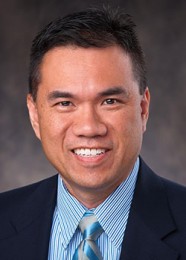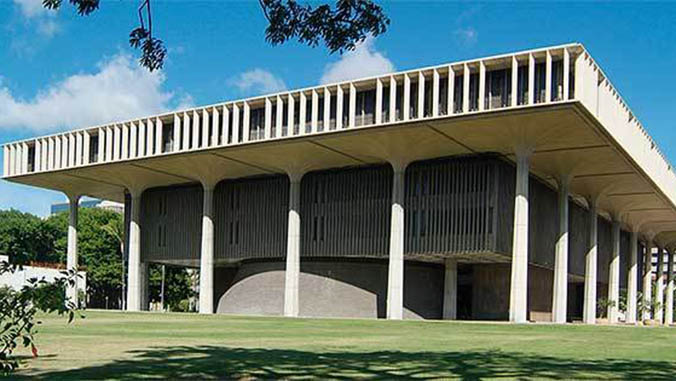
Kalbert Young, UH vice president for budget and finance and chief financial officer, shares his analysis of the 2018 legislative session.
The 2018 legislative session adjourned on May 3, with more than 200 bills being passed and moving on to the governor for final consideration. A fair number of these bills impacted the University of Hawaiʻi either directly or indirectly. I’ll highlight just a few of the significant measures to pass the legislature this year.
In 2017, the legislature appropriated funds for the Hawaiʻi Promise Program, which was implemented in fall 2017 as a “last dollar” scholarship program to provide for the unmet financial needs of qualified University of Hawaiʻi Community College resident students. As of today, approximately 1,500 students have benefited from the Hawaiʻi Promise Program. The Hawaiʻi State Legislature passed and approved HB 2501 CD1, which provides an additional appropriation of $700,000 for fiscal year 2019 to support this worthy cause.
The university had other funding requests for operations, programs and initiatives during the 2018 legislature. While some of these areas did receive funding support at the end of the legislative session, many were not funded and others that were funded were not initiated or originally requested by the university.
The supplemental budget bill (HB 1900 CD1) was the single most important measure at the legislature, because a lot of UH’s desired funding initiatives would have been provided via the budget appropriation bill. HB 1900 CD1 passed the legislature and has been transmitted to the governor for his consideration. The table below compares the UH items funded by the legislature vs. what was requested by the Board of Regents and the governor’s proposal when the legislature started in January.
| Campus | Description | UH BOR | Governor | Legislature |
|---|---|---|---|---|
| CCs | Hawaiʻi Promise Program | $700,000 | $700,000 | $700,000 |
| CCs | Architects / Engineers for Facilities | $273,600 | ||
| West Oʻahu | Health and Safety / Utilities / Equipment | $781,000 | $300,000 | $501,000 |
| Mānoa | Facilities | $4,038,848 | $1,500,000 | |
| CCs | Additional Positions for Security | $1,083,264 | ||
| Hilo | DKICP-Janitorial and Groundskeeping | $120,495 | $120,495 | |
| System | Office of Strategic Planning and Development | $500,000 | $90,000 | |
| Mānoa | Student Success Initiative-Veterans, Filipinos, Mental Health | $575,000 | $400,000 | $300,000 |
| CCs | Apprentice Lecturer Costs | $260,000 | $260,000 | $260,000 |
| CCs | Filipino Student Support | $614,920 | $350,000 | |
| CCs | Veterans Support | $473,108 | $473,108 | |
| Mānoa | Native Hawaiian Affairs Action Plan | $700,000 | $500,000 | |
| CCs | Native Hawaiian Student Support | $1,729,908 | $500,000 | |
| Hilo | Native Hawaiian Development | $260,000 | $200,000 | $79,000 |
| Hilo | Student Workforce | $200,000 | ||
| Mānoa | Student Research and Innovation | $535,000 | $175,000 | |
| Mānoa | Graduate Student Initiative-Phase I | $2,850,000 | $621,397 | |
| West Oʻahu | Academic Affairs Restructure and Growth | $680,000 | $400,000 | |
| West Oʻahu | Student Affairs | $446,364 | $200,000 | |
| Mānoa | CTAHR positions | $960,000 | ||
| Hilo | Rat Lungworm Research at DKICP | $300,000 | ||
| Hilo | Hawaiʻi Ant Lab | $200,000 | ||
| West Oʻahu | Health Sciences Academy | $515,000 | ||
| CCs | Student Success Initiative | $750,000 | ||
| CCs | Architects and Project and Construction Managers | $364,800 | ||
| CCs | Online Learning | $565,372 | ||
| System | Online Learning | $685,000 | ||
| Mānoa | Grant in Aid-Hawaiʻi Institute of Pacific Agriculture* | $75,000 | ||
| System | Grant in Aid-Friends of Ka Leo Hawaiʻi Media* | $150,000 | ||
| Total | $16,821,507 | $6,700,000 | $5,795,172 |
*HRS 42F-101 defines a Grant in Aid as “an award of state funds by the legislature, by an appropriation to a specified recipient, to support the activities of the recipient and permit the community to benefit from those activities.”
There were a few other bills that passed the legislature that will provide some operating funds for the University of Hawaiʻi. For example, there were appropriations of $150,000 for the Heʻeia National Estuarine Research Reserve and $500,000 for a cooperative study with the Department of Health on sewage contamination. Of note, is the funding for the Hawaiʻi Promise Program, whereas the legislature chose to fund the program for an additional $700,000, but did so outside of the budget appropriation bill so that conditions could be placed on the funding. Total Hawaiʻi Promise Program funding is now at approximately $2.5 million.
In general, I believe the university fared modestly given the amount of legislative attention in the budget. Much of the university’s original request was not funded, and although a sizeable portion of funding provided by the legislature was for areas that were not requested by UH, the funding support should provide some level of progress and improvements.
For capital improvement projects (CIP) and construction of facilities, HB 1900 CD1 provided a modest funding level for the University of Hawaiʻi System to address capital improvement projects and deferred maintenance. This has been consistently a major area of concern for the University. The legislature appropriated a total of $109.9 million in general obligation bonds for the following projects:
| Campus | Project Title | UH BOR | Governor | Legislature |
|---|---|---|---|---|
| Mānoa | Renew, Improve, Modernize (RIM) projects | $139,500,000 | ||
| Mānoa | Sinclair Library Renovation | $41,000,000 | $20,000,000 | $700,000 |
| Mānoa | Keller Hall Renovations, design phase | $1,500,000 | ||
| Mānoa | Athletics (UOH900) | $11,100,000 | ||
| Mānoa | Cancer Center Annex – Early Phase Clinical Trials Program (UOH900) | $200,000 | ||
| Hilo | Renew, Improve, Modernize projects | $27,900,000 | ||
| Hilo | Puako Marine Educational Center, design phase | $1,000,000 | ||
| Hilo | Hale ʻAlahonua Air Conditioning | $3,000,000 | ||
| Hilo | Phase II and Phase III of Haleʻōlelo Complex for College of Hawaiian Language | $500,000 | ||
| West Oʻahu | Renew, Improve, Modernize projects | $3,000,000 | ||
| West Oʻahu | Relocation of Dental Hygiene Program from UH Mānoa to UH West Oʻahu | $10,000,000 | ||
| West Oʻahu | Campus Center Extension | $5,000,000 | ||
| CCs | Capital Renewal and Deferred Maintenance | $25,000,000 | $12,000,000 | $10,000,000 |
| CCs | Minor Capital Improvement Projects | $10,000,000 | $10,000,000 | $10,000,000 |
| CCs | Multi-Agency Facility – site of current Wahiawa Public Library | $3,000,000 | ||
| CCs | Hawaiʻi CC – Campus Development, design phase | $2,000,000 | $2,000,000 | |
| CCs | Leeward CC – Repave Fascia and Replace Walkways Campuswide | $8,800,000 | ||
| CCs | Maui – Expansion of Culinary Arts Program to Lahaina | $400,000 | ||
| CCs | Hawaiʻi CC – Pālamanui Outdoor Learning Area and Dining Area Improvements | $1,173,000 | ||
| System | Renew, Improve, Modernize (RIM) Projects | $76,000,000 | $64,900,000 | |
| Total | $269,700,000 | $120,000,000 | $109,973,000 |
As you will notice, significant portions of CIP funding are for items not requested as part of the original budget, and funding for desired project areas is much less than originally requested. However, like the operating budget, the level of legislative funding support will help to make some small progress toward holding the line on building and facilities decline.
Along with the CIP budget, the legislature passed HB 2005 SD2, which authorizes the university to issue as much as $100,000,000 in revenue bonds. This authority could allow UH to finance additional construction and CIP projects, however, the university does not currently have any plans to issue these bonds any time soon since bonds require sufficient revenues to pay future debt service.
The University of Hawaiʻi is thankful and appreciative to the legislature for the support they provided for these capital needs across the UH System. A lot of work still needs to be done and additional funding will still need to be appropriated in order to reduce UH’s deferred maintenance backlog.
The governor has until July 10, 2018, to either sign, veto or allow bills to become law without his signature.


